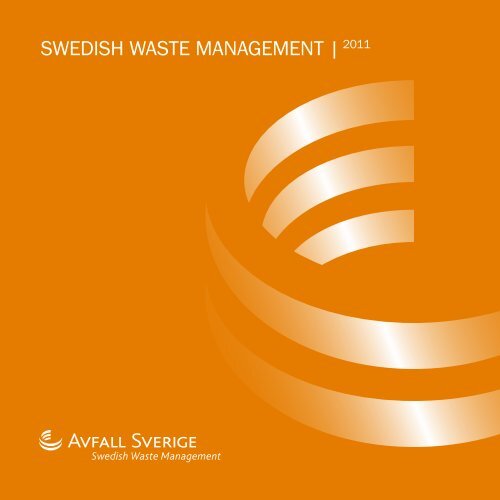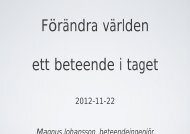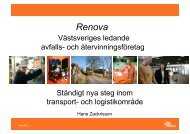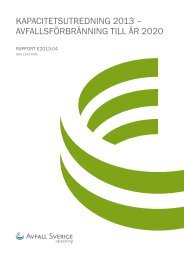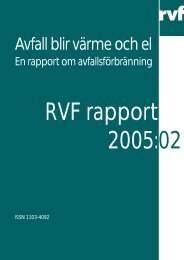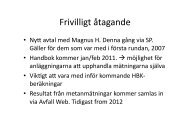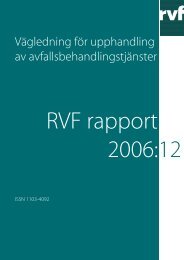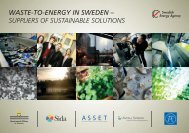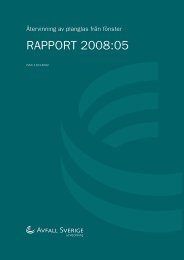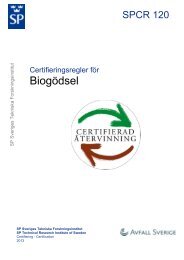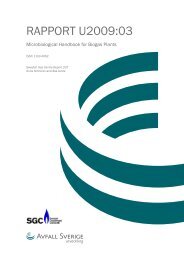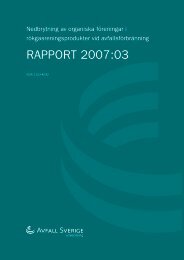SwediSh waSte management |2011 - Avfall Sverige
SwediSh waSte management |2011 - Avfall Sverige
SwediSh waSte management |2011 - Avfall Sverige
You also want an ePaper? Increase the reach of your titles
YUMPU automatically turns print PDFs into web optimized ePapers that Google loves.
Swedish waste <strong>management</strong> | 2011
Swedish waste <strong>management</strong> 2011ContentsPreface 3How Swedish waste <strong>management</strong> works 4Waste minimization 5Collection and transport 6Waste quantities 2010 8Hazardous waste 10Batteries 12Waste from Electrical and Electronic Equipment 13Material Recycling 14Biological Treatment 17Waste-to-Energy 21Landfills 24Waste Economics 26Waste other than household waste 28Waste agenda 29About <strong>Avfall</strong> <strong>Sverige</strong> – Swedish Waste Management 32Administrative office 332
Swedish waste <strong>management</strong> 2011PrefaceWaste <strong>management</strong> in Sweden is focusingmore and more on waste minimization andwaste prevention. Waste minimization is a toppriority for the members of <strong>Avfall</strong> <strong>Sverige</strong> –Swedish Waste Management. This philosophyis exemplified by the long term vision – “ZeroWaste” – adopted at the 2011 Annual Meeting.The vision includes two long-term goals for2020: a) to break the relationship betweenwaste and growth and b) to achieve clear,strong upward movement in the waste hierarchy.The municipalities are key players and thevision states that the municipalities are thedrivers in the transition and the guarantee forlong-term sustainable waste <strong>management</strong>.Sweden and Europe as a whole are strivingto reduce waste quantities. The EU frameworkDirective on Waste requires member states towork to prevent waste generation. Memberstates must develop waste reduction planswith the goal of reducing waste by 2020.Nationally, <strong>Avfall</strong> <strong>Sverige</strong> – Swedish WasteManagement and the local authorities are keyplayers in this process.<strong>Avfall</strong> <strong>Sverige</strong> – Swedish Waste Managementis also the national coordinator of the EUproject “European Week for Waste Reduction”,also supported by the Swedish EnvironmentalProtection Agency. The project is aimed atreducing waste quantities as well as theamount of hazardous substances in the waste.2010 saw the waste quantities decreasingfor the second consecutive year. While it is stilltoo early to draw substatial conclusions, it isencouraging that the trend may have reversed.It is imperative however, not to forget theimportant task of taking care of the waste thatis generated, despite all prevention efforts.From information and collection to processingand recycling, with constantly evolving methods,the Swedish waste <strong>management</strong> systemis today environmentally sound, sustainableand sociallially responsible.District heating from waste is replacing fossilfuels, as is biogas derived from food waste.Recycling helps to reduce extraction of virginraw materials.Sweden is one of the leading nations inwaste <strong>management</strong> –an impressive 99 percentof the household waste is recycled asenergy or material. The environmental objectiveto recycle at least 50 percent of householdwaste, including biological treatment, by2010 was essentially met.With Swedish Waste Management 2011, weturn to participants in the waste industry, policymakers, government agencies, educationalinstitutions, media and all other interestedparties. We present text, figures and tablesdescribing how household waste is handled inSweden.Statistics in the annual publication SwedishWaste Management 2011 are obtained fromthe Swedish Waste Management’s web-basedstatistics system <strong>Avfall</strong> Web, and from theproducers’ organizations. We hope this publicationwill increase interest in Swedish waste<strong>management</strong>.Weine Wiqvist, Managing Director<strong>Avfall</strong> <strong>Sverige</strong> – Swedish Waste Management3
Swedish waste <strong>management</strong> 2011How Swedish waste <strong>management</strong> works4Waste shall be managed in a way that achievesmaximum environmental and societal benefits.Everyone participates in this effort: producers,businesses, municipalities and households.The municipalities are responsible forhousehold waste, producers are responsiblefor their various product groups, and the operatorsin the sector are responsible for takingcare of all waste which is not household waste.Households are responsible for separatingand depositing waste at the various availablecollection points. Households are also responsiblefor complying with municipal waste <strong>management</strong>regulations.If possible, waste should be managed accordingto the waste hierarchy order of priority:• waste prevention• reuse• material recycling• recovery – such as energy recovery• disposalExceptions from the hierarchy may be necessaryfor technical, financial or environmentalreasons.EU decisions set the frameworks forSwedish waste <strong>management</strong>. The environmentalobjectives of the Swedish Parliament(Riksdag) have piloted Sweden toward moreenvironmental waste <strong>management</strong>. The country’smunicipalities have played a key role inthis effort.Now new milestones await. The All PartyCommittee on Environmental Objectives proposesthe following targets:• By 2015, food waste shall be reduced by atleast 20 percent compared with 2010• By 2015, at least 40 percent of food wastefrom households, caterers, retail premisesand restaurants will be biologically treatedto provide fertilizer and energy• By 2015, at least 60 percent of phosphoruspollution in effluent shall be treated andused on productive lands, of which at leasthalf should be used on arable land• By 2020, reuse and material recycling ofnon-hazardous construction and demolitionwaste shall be at least 70 percentThe most important treatment methods forwaste are:• material recycling• biological treatment• Waste-to-Energy• landfillHazardous waste can be treated with one orseveral of these methods, depending on thecharacter of the waste.Recycling of packaging, paper, scrap, wastefrom electrical and electronic equipment(WEEE), and batteries reduce the environmentalimpact and save energy and resources.Biological recycling is implemented throughanaerobic digestion or composting. Anaerobicdigestion produces biogas which can be usedas vehicle fuel. Anaerobic digestion also producesdigestate which is an excellent nutrient.Composting produces long-lasting fertilizerused as soil improver in gardens, parks and forground installations. Biological recycling thuscloses the ecocycle and returns nutrients tothe soil.Waste-to-Energy is an effective and environmentallysafe method for producing energy fromwaste. It provides both heat and electricity.Waste-to-Energy is a method well suited forwaste which cannot be treated in any other way.Landfilling is a treatment method for wastewhich cannot or should not be recycled.Landfilling means that waste is stored in amanner that is safe for the long-term, and thistreatment method is controlled by a strict regulatoryframework. Landfilling of organic orcombustible waste is forbidden.The local authorities may choose how toorganize waste <strong>management</strong>. This option formunicipal self-government is laid down in constitutionallaw. The local authorities may choose<strong>management</strong> system and municipal undertakings,separate or jointly with other municipalities.Cooperation is also possible in a jointcommittee or a local government federation.Some local authorities also cooperate onspecific matters, such as joint procurements.To many local authorities, collaboration is anatural solution to attain the best possibleenvironmental and social benefits, to achievecost-efficient waste <strong>management</strong> and to guaranteethe competence required, which benefitsboth residents and the environment.In 75 percent of Swedish municipalities,external actors, private companies, managehousehold waste collection, while in the restthe municipalities provide this service. Wastetreatment is effected either by the municipalitiesthemselves or by an external actor, oftena municipal enterprise or sometimes a privatecompany.
Swedish waste <strong>management</strong> 2011Waste minimizationPreventing waste generation is the top step ofthe EU’s waste hierarchy. It is also a priority inthe national environmental objectives and inthe national waste plan.In Sweden we are good at recovering material,energy and nutrients from waste, whichprovides major environmental benefits. Butwe can achieve even more. The environmentalbenefit is greater if a product is never producedthan if it is produced, used and ultimatelyrecycled.Swedish municipalities have accepted alarge responsibility to reduce waste and thequantity of hazardous substances in the wastethat is generated. A report from <strong>Avfall</strong> <strong>Sverige</strong>– Swedish Waste Management 1 provides ahost of examples of measures that have actuallysucceeded in substantially reducing wastequantities:• Kretsloppsparken Alelyckan in Gothenburgprevents 360 tons of waste annuallybecause products can be reused instead ofdiscarded.• Kiruna reduced food waste in school cafeteriasby eliminating food trays – pupils canno longer take as much food each time.• Bjurhovda School in Västerås received anaward for its efforts to reduce the amount offood thrown away in the school cafeteria.When the project began, the school threwaway ten kilograms of food daily; one yearlater the figure was down to 6.8 kilogramsdaily. Averaged over one year, food wastewas reduced by 640 kilograms, resulting inboth economic savings and lower environmentalimpact.• Gästrike Återvinnare is heavily engaged in awaste reducation campaign. All municipalitywaste collection vehicles paraded throughthe center of town to demonstrate theamount of waste generated in Gävle.• Gävle is also running the Hållbara familjer(Sustainable Families) project, in which severalfamilies are tasked with changing theirlifestyle in a more environmentally awaredirection for one year. The project focuseson energy, food, travel and recycling.• Gothenburg is running a similar project,Leva livet (Live Life). Families reduced foodwaste by one quarter, newspapers andmagazines by one tenth and ordinary trashby about 40 percent over the course of theproject.Waste minimization is a top priority for themembers of <strong>Avfall</strong> <strong>Sverige</strong> – Swedish WasteManagement. This philosophy is exemplifiedby the long term vision – “Zero Waste” –adopted at the 2011 annual meeting. Thevision includes two long-term goals for 2020:a) to break the relationship between wasteand growth and b) to achieve clear, strongupward movement in the waste hierarchy. Themunicipalities are key players and the visionstates that the municipalities are the driver inthe transition and the guarantee for long-termsustainable waste <strong>management</strong>.The vision and the long-term objectives for2020 are the result of a project that membersparticipated in for one year.<strong>Avfall</strong> <strong>Sverige</strong> – Swedish Waste Managementis also the national coordinator of the EUproject “European Week for Waste Reduction”,which is also supported by the SwedishEnvironmental Protection Agency. The projectruns in November with organized activitiesthroughout Europe aimed at reducing wasteand the quantity of hazardous substances inwaste. The project began in 2009 and endedin its current form in 2011, but will be replacedby a new project that will run until 2015.1 U 2011:05 Good Examples of Waste Prevention in Municipalities A compilation of ideas for more sustainable production and consumption5
Swedish waste <strong>management</strong> 2011Collection and transportThere are various systems for collection andtransport of household waste. The householdwaste in bins and bags may be collected eitheras a mixed fraction intended for Waste-to-Energy or in separate fractions – one for foodwaste and one for combustible waste. About30 municipalities have also introduced curbsidecollection of packaging and newspapersfrom single-family homes.Mixed combustible waste from single-familyhouses is in most cases collected in 190 literwheelie bins and emptied every other week.There are also a number of different bag andbin sizes which are emptied in various intervals.Waste is usually collected from apartmentblocks every week.The most common systems for collection ofsource-separated food waste is by separatebins – one for bio-waste and one for combustiblewaste – by multi-compartment bin, or byoptical sorting. Optical sorting requires householdsto separate waste into different coloredbags that are placed in the same bins. Thebags are then taken by the waste collectionvehicle to an optical sorting facility where thebags are separated automatically for the righttreatment.Traditional rear-loading vehicles are still themost common waste colletion vehicles, butthe technology for multi-compartmented vehi-cles is developing and becoming more andmore popular, while side-loading vehiclesaccount for a more constant share of theoperators’ vehicle fleet.An increasing number of vehicles usebiogas as fuel, which the local authorities maycontrol through procurement requirements. Inaddition, several municipalities use otheralternative fuels such as RME, as well as varioushybrid technologies in vehicles to reducetheir carbon footprint.Waste collection previously was subject tovarious work-related injuries. Daily heavy liftingwas part of the job and waste collectionrequired workers to be in good physical shape.Due to the tough working conditions howeverfew waste collectors were able to physicallylast until the national average retirement age.Today the situation is different. Bags havebeen replaced with bins or other types of containers.Manual handling of waste is beingreplaced with new technology and automatedsystems, such as refuse vacuum systems andunderground container systems. Both of thesesystems are on the rise, particularly in largecities. One of several advantages is that theydo not require as heavy manual handling.From the standpoint of occupational healthand safety, vacuum collection is a good systemsince it is sealed and completely automated.This type of collection system reducesthe need for waste transportation, especiallyin residential areas. There are two kinds ofvacuum collection systems, a stationary systemand a mobile system. With the stationarysystem, waste is collected with air in an automatedvacuum system. It is transportedthrough underground tubes, which connectthe inlets with big containers placed in a terminal.With this technique, waste can be transportedup to a distance of two kilometers fromthe inlets. The number of containers variesand depends on the one hand upon thenumber of collected fractions, and on theother hand on the waste volumes. The containersare collected by hook-lift vehicles.The mobile vacuum collection system alsouses air to collect the waste, but here thevacuum technique sits in the vehicle. A storagetank is positioned under each inlet. Thetanks are connected, via an underground pipesystem, to a so called docking point which canbe placed at a maximum distance of 300meters from the tanks. The vehicle connectsto the docking point for emptying, the vacuumsystem is turned on and air transports thewaste from the different storage tanks to thedocking point and onto the vehicle. Mobilevacuum collection systems require specializedvehicles.6
Swedish waste <strong>management</strong> 2011Another collection system that is on the riseis the underground container system. Placinglarger containers underground reduces theneed for space on street level. The temperaturebelow street level, where the waste iscontained, is relatively low, which preventsodor, and the containers are easily emptiedwith a hook lift vehicle. There are also undergroundcontainers that are emptied with frontloadingvehicles. Since the underground containerscarry larger volumes, the number oftransports can be reduced.At the municipalities’ manned recyclingcenters, the households themselves drop offbulky waste, electronic waste and hazardouswaste. Bulky waste is household waste, whichis too heavy, too bulky or for other reasonsinappropriate for collection in bags or bins. In2010, households dropped off 1.5 million tonsof bulky waste, most of which was handed tothe manned municipal recycling centers. Asmaller part, about ten percent, was collectedthrough curbside collection. The bulky wastevolumes correspond to 161 kg per person.There are about 600 recycling centers throughoutthe country, and in total they receive about20 million visits annually.The volumes of bulky waste and hazardouswaste that are handed to the recycling centershave increased significantly in recent years.Several municipalities have therefore adaptedand modernized their recycling centers.Smaller recycling centers are typically closedwhen the municipalities build new, larger centersbetter-suited to the waste quantities andnumber of visitors.Several recycling centers in Sweden havehad severe problems with burglaries andthefts in recent years, as well as incidentswhen staff have been personally threatened.Most of the larger modern recycling centershave therefore installed electric fences, whichhave considerably reduced the number ofbreak-ins. In order to improve safety, and forthe sake of a functional system for accesscontrol that would enable more accurate visitorstatistics, several of the municipalities alsointroduced a barrier gate system at the recyclingcenters. This system is often combinedwith an entry card which allows households toa certain number of free visits. Small businessowners may also use the services offered atthe recycling centers in several of the municipalitiesfor a fee.The producers’ system includes approximately5,800 unmanned recycling stations forpackaging and newspaper that cover theentire country. The collection systems shouldbe formed in consultation with both producersand local authorities. The recycling stationshave separate bins for newspaper and variouspackaging material.A growing number of municipalities areimplementing curbside collection of packagingand newspaper from apartment blocks andsingle-family homes.According to a survey by <strong>Avfall</strong> <strong>Sverige</strong> –Swedish Waste Management 2 , about 60 percentof what households place in trash bagscan be recycled and in households that do notsort food waste the figure is almost 80 percent,.The survey has compiled 246 Waste-Analyses carried out in Sweden’s municipalitiessince 2007. Single-family homes are generallybetter at sorting out recyclable materials;about 20 percent of their household wasteconsists of packaging and newspapers. Inapartment households this figure is 36 percent.One half percent of the waste is hazardouswaste, batteries and waste from electricaland electronic equipment (WEEE).The system chosen for collection alsoaffects the degree of sorting. Single-familyhomes with curbside collection, source separatethe waste most effectively, with half theamount of packaging and paper in the trashcompared to other households.2 U2011:04 National survey of random analyses of household bins and bags of waste7
Swedish waste <strong>management</strong> 2011Waste quantities 2010In 2010 the quantity of household wastedecreased for the second consecutive year.The quantity of treated household waste was4,363,880 tons, a reduction of 2.7 percentcompared with 2009. Divided over the population,each Swedish resident produced 463 kgof household waste in 2010, to be comparedwith 480 kg per person in 2009.It is too early to draw long-term conclusionsfrom the decline in the amount of waste overthe past two years. Nevertheless, it is encouragingthat the trend has reversed, even if itproves to be only temporary.In Sweden 1 percent of household wastewas landfilled in 2010, a decrease of 33 percentfrom 2009.The environmental objective to recycle atleast 50 percent of household waste, includingbiological treatment, by 2010 was essentiallymet. A total of 49.2 percent of householdwaste went to material recycling or biologicaltreatment and 48.7 percent went to energyrecovery. The breakdown is essentially thesame as for 2009.Hazardous waste accounted for 1.2 percentof household waste, an increase of 13 percentcompared with 2009. The figure for hazardouswaste now also includes asbestos.Biological treatment of food waste, excludinghome compost, increased by 20 percent to214,300 tons in 2010.Anaerobic digestion increased by 21 percentcompared with 2009. Composting isdeclining, probably because branches andlarge twigs now go to Waste-to-Energy insteadof to composting.This year we can also report the collectedvolume of waste in bins and bags as well asbulky waste.Collected volume of WASTEbins and bags as well as bulky waste 2006–2010 (tons)2006 2007 2008 2009 2010Waste in bins and bags 2,234,300 2,211,900 2,226,700 2,167,800 2,152,000Bulky waste 1,237,200 1,227,400 1,421,100 1,498,400 1,518,000(Kg/person)2006 2007 2008 2009 2010Waste in bins and bags 245 241 241 232 229Bulky waste 136 134 154 160 161Source: <strong>Avfall</strong> Web/<strong>Avfall</strong> <strong>Sverige</strong> - Swedish Waste Management 20118
Swedish waste <strong>management</strong> 2011Treated quantity household waste 2006–2010 (tons)2006 2007 2008 2009 2010Hazardous waste 38,960 40,880 43,320 45,380 51,430Material recycling 1,657,520 1,737,720 1,657,840 1,586,600 1,559,600Biologic treatment 469,880 561,300 597,280 617,680 587,170Waste-to-Energy 2,107,860 2,190,980 2,292,970 2,173,000 2,123,680Landfill 226,000 186,490 140,250 63,000 42,000Total quantity treated 4,500,220 4,717,370 4,731,660 4,485,660 4,363,880Treated quantity household waste 2006–2010 (KG /PERSON)2006 2007 2008 2009 2010Hazardous waste 4.3 4.5 4.7 4.9 5.5Material recycling 181.9 189.2 179.1 169.9 165.6Biologic treatment 51.6 61.1 64.5 66.1 62.4Waste-to-Energy 231.3 238.6 247.7 232.6 225.5Landfill 24.8 20.3 15.2 6.7 4.5Total quantity treated 493.8 513.7 511.2 480.2 463.5Treated quantity household waste 2006–2010 (%)2006 2007 2008 2009 2010Hazardous waste 0.9 0.9 0.9 1.0 1.2Material recycling 36.8 36.8 35.0 35.4 35.7Biologic treatment 10.4 11.9 12.6 13.8 13.5Waste-to-Energy 46.8 46.4 48.5 48.4 48.7Landfill 5.0 4.0 3.0 1.4 1.0Total quantity treated 100 100 100 100 100Source: <strong>Avfall</strong> <strong>Sverige</strong> - Swedish Waste Management2000-2010tons2,500,0002,000,0001,500,0001,000,0005432milj. tons500,00010-00 -01 -02 -03 -04Hazardous wasteMaterial recyclingBiological treatment-05 -06 -07 -08 -09 -10Incineration with energy recoveryLandfill02006 2007 2008 2009 2010Hazardous wasteMaterial recyclingBiological treatmentIncineration with energy recoveryLandfill9
Swedish waste <strong>management</strong> 2011Hazardous WasteIn 2010, 51,430 tons of hazardous wastewere collected from households. On averageeach Swede handed in 5.5 kg of hazardouswaste. The quantity also includes 25,030 tonsof impregnated wood and 4,370 tons of asbestos.Hazardous waste represented 1.2 percentof the household waste.Hazardous waste can be toxic, carcinogenic,corrosive, toxic for reproduction, ecotoxic,infectious or flammable. The hazardous substancesmay occur in extremely small quantitiesin some products, but collectively they cancause substantial damage if they end up in thewrong place. It is therefore important thathazardous waste is separated from otherwaste and handed in correctly.Local authorities are responsible for hazardoushousehold waste. The responsibilityencompasses collection, transport, and treatment.The responsibility is regulated by theEnvironmental Code, the Waste Collection andDisposal Ordinance, and the Municipal WasteRegulation Ordinance.Households are responsible for separatinghazardous waste from other household waste.Most local authorities have regulated this obligationin the Regulation Ordinance for a longtime.At a national level, Sweden lacks a follow-upsystem for hazardous waste from industriesand other types of businesses. No precisestatistics are available for the amounts of hazardouswaste from industries, but according toofficial Swedish waste statistics, reported tothe EU by the Swedish EnvironmentalProtection Agency, Swedish households andenterprises produced 2.3 million tons of hazardouswaste in 2008, including scrap vehicles,electrical waste etc. Householdsaccounted for 15 percent of hazardous wastegenerated in Sweden in 2008.The most common collection system forhazardous household waste is through dropoff at manned municipal recycling centers.Several municipalities have stopped using theunmanned recycling stations and have insteadintroduced some form of curbside collection.Approximately one third of all municipalities inSweden offer curbside collection, often incombination with several other collection systems.Hazardous waste dropped off at collectionor treatment facilities often require pre-treatmentto facilitate further treatment. Sincehazardous waste may contain substanceswhich are to be phased out of the ecocycle,the treatment often aims at destroying thesesubstances. Substances that cannot be renderedharmless or reused will be disposed tolandfills. In these cases it is important that the10
Swedish waste <strong>management</strong> 2011waste is chemically and physically stable sohazardous substances do not leak out to surroundingareas.New treatment methods for recycling hazardouswaste have been developed, whichinvolve the separation of hazardous substancesand recycling of the remaining parts. Themethod is used for treatment of, for instance,paint tins and oil filters. Toxic and poorlydegradable substances, such as pesticidesand other hazardous chemical waste, areincinerated in specialized furnaces at hightemperatures. Contaminated soil can bedecontaminated through biodegradation.Impregnated wood contains ecologically harmfulsubstances such as arsenic, creosote, andcopper. Collected wood is chipped and incineratedin specially licensed Waste-to-Energyplants.Collected quantity of hazardous waste 2006–2010tons55,00050,00045,00040,00035,00030,00025,00020,00015,00010,0005,0000-06 -07 -08 -09 -10Collected quantity of hazardous waste (excl. asbestos and impregnated wood)Collected quantity of hazardous waste (incl. impregnated wood)Collected quantity of hazardous waste (incl. asbestos and impregnated wood)Source: <strong>Avfall</strong> Web/<strong>Avfall</strong> <strong>Sverige</strong> - Swedish Waste Management 201111
Swedish waste <strong>management</strong> 2011BatteriesA new producer responsibility for batteriescame into effect on January 1, 2009. It madebattery producers responsible for collection,treatment, recycling, and disposal of all batteriesregardless of when they appeared on themarket. Producers are also responsible forrunning nationwide information activities.El-Kretsen manages collection of portable batteriesin about 70 percent of municipalities,while the remaining municipalities managecollection in exchange for an agreed compensationfrom El-Kretsen.In 2010, 2,260 tons of portable batteriesand 490 tons of built-in batteries were collected,on average 290 grams per Swedishresident. This represents an increase of 60percent compared with 2009, but a large partof the increase depends on a time lag in thereport from the municipalities in conjunctionwith new agreements with the producers.In 2010, 7,000 tons of car batteries, anaverage of 0.7 kg per resident, were collected– a 30 percent increase compared with theprevious year.All collected batteries are taken care of andseparated based on chemical content beforebeing sent to recovery or disposal:• Car batteries are sent to recycling and thelead is re-used in new car batteries.• Batteries containing nickel/cadmium aresent for treatment, where cadmium is reusedfor so-called open nickel cadmiumbatteries, which are used in industry. Nickelis recovered as well, but is sent to steelmills.• Nickel metal hybrid batteries are recoveredand nickel is returned to the ecocycle.• Batteries containing mercury are sent forprocessing. Mercury should not be recovered.Therefore, work is under way to extractthe mercury from batteries in order to takeit out of circulation and dispose of it safely.• Lithium batteries are taken care of to recovercobalt, which can be used for purposessuch as an additive in the steel industry.All batteries should be collected and recycledas far as possible.Collection of sm all batteries 1999-2010kg/person0.350.300.250.200.150.100.050.0-99 -02 -03 -04 -05 -06 -07 -08 -09 -10Incorporated batteriesPortable batteriesSmall batteriesSource: El-Kretsen and <strong>Avfall</strong> Web/<strong>Avfall</strong> <strong>Sverige</strong> 201112
Swedish waste <strong>management</strong> 2011WASTE from Electrical and Electronic Equipment (WEEE)In 2010, 143,830 tons of waste from electricaland electronic equipment (WEEE) werecollected, which is an unchanged amountcompared with 2009. An average of 15.3 kg ofelectronic waste was handed in per person in2010, compared with 15.4 kg per person in2009. The slight decrease in weight do notmean that the collection has decreased. Thecollected products are becoming smaller andweigh less, but are more numerous.Since producer responsibility was implementedin Sweden regional governments andproducers have cooperated in the <strong>management</strong>of WEEE. In 2001, <strong>Avfall</strong> <strong>Sverige</strong> –Swedish Waste Management, the SwedishAssociation of Local Authorities and Regions(SALAR), and the electrical producers’ servicecompany, El-Kretsen, created the “El-retur”system. Under this collaboration, the localauthorities assume responsibility and receivecompensation for collection of WEEE fromhouseholds, while the producers are responsiblefor its treatment.Collection of WEEE from households is primarilycarried out at the manned municipalrecycling centers, of which there are approximately600 throughout the country. In somemunicipalities this is complemented by curbsidecollection. <strong>Avfall</strong> <strong>Sverige</strong> – Swedish WasteManagement and El-Kretsen collaborate withseveral local authorities on different projectsto develop these collection systems. One suchsystem is the collection of light bulbs andsmaller electric and electronic waste intosmall containers, which are placed in storesand other public places. There are currentlyabout 100 collection containers located allover Sweden.WEEE is pretreated through sorting anddismantling before it is sent on for furthertreatment. Pretreatment is carried out in certifiedfacilities, and later forwarded to finaltreatment or recycling.Components containing hazardous substances,i.e. hazardous waste, are treated inapproved treatment facilities. Once the hazardoussubstances are removed, much can berecycled. Plastic casings are incinerated inWaste-to-Energy plants, and metal is recycledin smelting plants. Recovered copper, aluminiumand iron are used as raw materials in newproducts. Computers, mobile phones andother IT products contain small amounts ofprecious metals that are also recovered; forexample, some printed circuit cards may containgold and/or silver. Fluorescent tubes andlow-energy bulbs contain mercury. These productsare therefore separated and treated in aclosed process. The fluorescent powder andmercury can be reused in new production oflight sources. The glass is cleaned and reusedin glass jars and bottles.Sometimes old electronic products aredonated to other countries as charity, for whatmay seem to be a good cause, but is not environmentallyfriendly. From an environmentalpoint of view, it is better to have these productsrecycled in Sweden, where we have methodsto treat such waste in an environmentallysound way.Collected quantity of WEEE 2003-2010tons200,000150,000100,00050,0000-03 -04 -05 -06-07Collected quantity of WEEE-08 -09 -10Source: El-Kretsen13
Swedish waste <strong>management</strong> 2011Material RecyclingMaterial recycling including biological recyclingand in total accounted for 2,146,770tons in 2010. The Swedish Parliament has setthe goal of having at least 50 percent ofhousehold waste going to material recycling,including biological treatment, by 2010. Thegoal was essentially reached: material recyclingincluding biological recycling reached49.2 percent in 2010.The part of material recycling that includeselectronic waste, refrigeration units, batteriesand bulky waste collected as metal fraction inmunicipal recycling centers was 312,630 tons,or 33.2 kg per person.Metal from households, such as bicyclesand garden furniture, discarded at recyclingcenters decreased somewhat. In 2010159,050 tons of metal were dropped off forrecycling, or 16.9 kg per person.Packaging and paper are mainly collectedthrough some 5,800 unmanned recycling stationsthat the producers run. However, theseitems can also be collected at the mannedmunicipal recycling centers and about thirtymunicipalities have implemented curbside collectionof packaging and paper from singlefamilyhomes.The statistics for Packaging and paper recyclingfor 2010 will not be reported until 2012because the method for reporting statistics iscurrently under review. As a result amountscollected are only reported here. The figures inthe table are therefore not comparable withprevious years.<strong>Avfall</strong> <strong>Sverige</strong> – Swedish Waste Managementis running a national campaign on materialrecycling in 2010-2011. The campaign isarranged in cooperation with the Swedishmunicipalities. The objective of the campaignis to increase knowledge about material recyclingand improve confidence in the municipalities’work on this matter.14
Swedish waste <strong>management</strong> 2011Material recycling 2010collection Results 2010 Packaging and paper household[tons] [kg/person] [tons] [kg/person]Office paper 132,000 14.0 newspaper 396,300 42.1WEEE 117,100 12.4 cardboard packages 111,860 11.9Refrigeration units 26,730 2.8 metal packages 15,820 1.7Portable batteries 2,750 0.3 Plastic packages 41,150 4.4Car batteries 7,000 0.7 glass packages 176,820 18.8Metal from household waste 159,050 16.9Source: <strong>Avfall</strong> <strong>Sverige</strong> – Swedish Waste Management,El-kretsen and Svensk ReturpappersföreningSource: Förpacknings- och tidningsinsamlingen (FTI)To calculate total waste volume, amount per capita was multiplied by number of residentson December 31, 2010; taken from Statistics SwedenFTI only reported collection results for 2010, not recycling results. Figures are thereforenot comparable with previous years.Material recycling household 2006-2010 (tons)2006 2007 2008 2009 2010Newspaper 483,000 474,000 459,000 420,000 -Office paper 153,000 164,000 156,000 118,000 132,000Cardboard packages 486,790 504,000 482,000 479,700 -Metal packages 33,700 35,300 32,660 33,400 -Plastic packages 42,130 49,120 50,310 44,430 -Glass packages 159,000 171,100 174,170 177,300 -WEEE 121,900 129,700 122,900 117,770 117,100Refrigeration units 28,000 30,500 28,800 26,080 26,730Batteries 9,750Metal from household waste 150,000 180,000 152,000 169,920 159,050Total 1,657,520 1,737,720 1,657,840 1,586,600 1,559,600Kg per person 181.9 189.2 179.1 169.9 165.6Batteries includes portable batteries and car batteriesBatteries are included in the recycling statistics beginning in 2010Source: <strong>Avfall</strong> <strong>Sverige</strong> – Swedish Waste Management, El-kretsen and Svensk ReturpappersföreningMaterial recycling household16tons2,000,0001,800,0001,600,0001,400,0001,200,0001,000,000800,000600,000400,000200,00001975 1980 19851990 1995 2000 2005 2010
Swedish waste <strong>management</strong> 2011Biological TreatmentIn 2010, 587,170 tons of household wastewas biologically recycled through anaerobicdigestion or composting. Which is a decreaseof 4.9 percent compared with 2009. A total of62.4 kg of waste – green waste and foodwaste – was biologically treated in 2010.Biological treatment now accounts for 13.5percent of the total quantity of treated householdwaste. One explanation for this reductionmay be that branches and large twigs now goto Waste-to-Energy instead of to composting,which is considered to be better from thestandpoint of resources and the environment.Collection and treatment of source-separatedfood waste increased by 20 percent in2010 compared with 2009. According to asurvey that <strong>Avfall</strong> <strong>Sverige</strong> – Swedish WasteManagement carried out, 163 municipalitiescollects source-separated food waste. About20 of them only collect food waste from restaurantsand large-scale kitchens, while theremaining municipalities have systems forhouseholds as well. The survey also showsthat an additional 70 municipalities are planningto introduce systems for source-separationof food waste.According to <strong>Avfall</strong> <strong>Sverige</strong> – Swedish WasteManagement’s calculations, an estimated 24percent of food waste was biologically treatedin 2010. Household waste analyses show thata single-family home produces about 90 kg offood waste per person annually. The figure forapartment block residents is higher, about100 kg. Food waste is also collected fromsources such as schools and restaurants. 3Food waste mainly consist of fruit and vegetableresidues, but a compilation from theNational Food Administration shows that alarge part is also fully edible food, more than50 kilo per person annually. Between 10 and20 percent of all purchased food is discardedcompletely unnecessarily, since it could havebeen eaten if it had been treated differently,according to the study.The most common collection system forsource-separated food waste from single-familyhomes uses two separate bins, one for foodwaste and one for combustible waste. A multicompartmentsystem is also available in whichdifferent fractions are separated into separatecontainers. Another collection system sometimesused, is optic sorting of different coloredbags that are put into the same container.Through anaerobic digestion of biologicalwaste, biogas, consisting of methane and carbondioxide, is produced. Biogas is renewableand can be used, after upgrading, as an environmentallysound vehicle fuel or for heating.The biogas produced from waste, correspondswith over 30 million liters of petrol/gasoline.Anaerobic digestion also produces digestate,which is an excellent fertilizer with a highnutrient content. The Swedish organic label“KRAV” and the Swedish Seal of Quality“Svenskt Sigill Kvalitetsråd” approve digestatebased on source-separated food waste, whichis certified in accordance with <strong>Avfall</strong> <strong>Sverige</strong>– Swedish Waste Management’s system.Using digestate instead of mineral fertilizer3 <strong>Avfall</strong> <strong>Sverige</strong> 2006:07 ”Matavfall från restauranger, storkök och butiker – nyckeltal med användarhandledning”17
Swedish waste <strong>management</strong> 2011returns nutrients to the soil, including phosphorus,which is a finite resource.Compost is primarily used for soil improvementor in soil mixtures.Facilities that produce compost or digestatefrom separated bio-waste, including food wastefrom the food industry, can undergo certificationto use quality labels on their product.<strong>Avfall</strong> <strong>Sverige</strong> – Swedish Waste Managementdeveloped the certification system about tenyears ago in consultation with the food andagriculture industry, compost and digestatemanufacturers, soil manufacturers, authoritiesand researchers. SP Technical ResearchInstitute of Sweden is the inspection body ofthis certification system.Certification places requirements on theentire waste <strong>management</strong> chain, from incomingwaste to final product. Eleven biogasplants – Bjuv, Falkenberg, Helsingborg,Kalmar, Kristianstad, Laholm, Linköping,Norrköping, Uppsala, Västerås, andVänersborg – as well as three compostingplants – Borlänge, Malmö, and Örebro – haveobtained certificates.<strong>Avfall</strong> <strong>Sverige</strong> – Swedish Waste Managementengaged in a voluntary initiative to minimizeemissions from biogas and upgrading plants.Air emissions may arise from different stagesof biological treatment through anaerobicdigestion of organic material and in biogasupgrading processes in treatment plants.Even though the emissions from biogasplants are low, they should be minimized forseveral reasons. Approximately 30 biogas andupgrading plants have signed up for the voluntaryundertaking.Ton 2006 2007 2008 2009 2010Anaerobic digestion 283,730 356,090 405,580 535,930 661,620Composting 452,390 515,290 568,700 630,500 566,210Total biologic treatment 736,120 871,380 974,280 1,166,430 1,229,840food waste 134,990 166,810 162,680 178,770 214,230Total quantity of household waste treated biologically* 469,880 561,300 597,280 617,680 587,170 *Digestate (tons) 272,730 336,100 389,350 498,720 582,750Raw gas (MWh) 181,270 228,810 280,000 317,440 328,110Vehicle gas (MWh) 106,430 149,230 204,720 262,600 264,680Electricity (MWh) 1,680 1,230 700 0 0Heating (MWh) 63,600 67,960 48,740 41,280 50,980Total (MWh) 181,270 218,410 254,160 303,870 315,660* Includes 60,000 tons of home compost.18
Swedish waste <strong>management</strong> 201119
Swedish waste <strong>management</strong> 2011Composting Total (tons) household wasteAle 1,830 420Alingsås 1,820 1,820Borlänge 11,260 10,660Borås 1,800 1,800Eslöv 11,340 11,340Fagersta 3,670 630Gällivare 9,150 4,920Gävle 12,780 12,780Göteborg 29,400 23,280Halmstad 23,000 6,280Helsingborg 19,960 19,960Huddinge 16,110 16,110Hässleholm 9,420 8,330Karlshamn 11,220 8,920Karlskrona 7,500 7,240Karlstad 51,090 300Klippan 5,150 4,070Kristianstad 15,000 13,000Kristinehamn 14,980 0Kungsbacka 6,410 1,900Landskrona 5,650 2,720Ludvika 9,770 5,580Luleå 11,410 11,410Malmö 27,800 27,800Mariestad 1,570 0Motala 6,600 3,300Norrtälje 1,510 1,510Sala 8,850 5,410Simrishamn 4,600 4,600Söderhamn 5,600 800Södertälje 9,000 6,000Tranås 1,880 250Trelleborg 5,900 5,900Täby 20,250 6,900Uppsala 15,800 14,850Västerås 10,000 10,000Växjö 5,200 5,200Ystad 7,500 7,500Örebro 14,000 12,040Östersund 11,740 11,650Total 447,520 297,180Other plants 118,690 118,690Sweden 566,210 415,870Anaerobic digestion Total (tons) household wasteBjuv 57,000 0Boden 22,900 2,300Borås 30,600 22,600Eskilstuna 75,630 6,630Falkenberg 94,060 0Falköping 28,670 2,280Helsingborg 54,110 15,240Huddinge 830 770Jönköping 13,360 8,210Kalmar 28,670 0Kristianstad 90,420 15,180Laholm 58,740 1,090Linköping 47,500 0Norrköping 15,600 0Skellefteå 6,620 5,090Uppsala 7,540 6,280Vänersborg 12,410 11,870Västerås 16,960 14,980Total 661,620 112,520BIOLOGICAL TREATMENT 1975 – 2010ton700,000600,000500,000400,000300,000200,000100,00001975 1980 19851990 1995 2000 2005 201020
Swedish waste <strong>management</strong> 2011Waste-to-EnergyIn 2010, 2,123,680 tons of household wastewere treated by incineration with energy recovery– Waste-to-Energy. This was a reduction ofclose to 50,000 tons compared with 2009. Ifdivided over the Swedish population, 225.5 kgof household waste per person was incineratedlast year. Waste-to-Energy accounts for48.7 percent of the total quantity of treatedhousehold waste.Waste has become an increasingly importantsource in Swedish district heating systems.In total, 14.4 GWh of energy was producedthrough incineration, of which 12.6GWh was used for heating and 1.8 GWh forelectricity. A study on European Waste-to-Energy production shows that Sweden has thehighest rate of energy recovery from wasteincineration. 4In addition to household waste, 2,977,000tons of other waste was also treated, primarilyindustrial waste. The statistical informationmainly refers to plants treating householdwaste. Energy recovery also takes place inplants where household waste is not treated,but there is no comprehensive data on totalenergy produced by incineration of waste inSweden.The remains from incineration consist ofbottom ash from the furnace, 15–20 percentby weight of the treated waste, and flue gastreatment residues, 3–5 percent by weight.Some of the bottom ash goes to landfills, whileslag gravel may be used as substitute to naturalgravel in, for example, road and landfillconstruction work.Flue gas treatment residues are eithertransported to landfills or used for neutralizationwhen refilling mines.There are 30 plants for incineration ofhousehold waste in Sweden, which will continueto expand in 2011.Imported waste used for energy recoveryhas increased in recent years.In 2010, Sweden imported 104,000 tons ofhousehold waste. Total imports of waste forenergy recovery was 748,000 tons. <strong>Avfall</strong><strong>Sverige</strong> – Swedish Waste Management andSwedish District Heating Association have carriedout a study that indicates a decline ingreenhouse gas emissions as a result ofimports. 5 The main reason for the large emissionreduction is that imports replace wastetreatment in the country of origin, especiallylandfilling, which entails a considerable reductionof emissions of the greenhouse gas methane.Waste transports provide only a marginaladdition of greenhouse gases in this context,according to the survey.According to the EU Framework Directive onWaste, waste incineration with effective energyrecovery is regarded as recycling. It is asanitary and environmentally sound treatmentmethod of such waste which cannot or shouldnot be treated otherwise.Swedish waste incineration plants morethan comply with the so-called energy criterionin the EU Framework Directive on Waste,which is a requirement to be considered arecovery operation.4 U 2009:05 Energy from waste – An international perspective5 U 2009:18 Energy from waste – Potential contribution to EU renewable energy and CO 2reduction targets21
Swedish waste <strong>management</strong> 2011Processed waste (tons)Waste to Energy (MWh)Municipality Plant Household waste Total Heat ElectricityAvesta Källhagsverket 16,200 54,430 175,710 0Boden Bodens Värmeverk 33,330 95,170 246,670 28,010Bollnäs Säverstaverket 40,430 51,130 137,570 0Borlänge Fjärrvärmeverket, Bäckelund 43,560 90,960 203,320 33,380Borås Ryaverket 26,280 105,870 226,700 49,700Eda Åmotsfors Energi 20,700 59,790 148,270 12,600Eksjö Eksjö Energi AB 20,520 50,710 95,300 15,310Finspång FTV Värmeverket 21,600 27,140 59,700 0Göteborg Sävenäs avfallskraftvärmeverk 251,890 539,120 1,440,620 220,930Halmstad Kristineheds avfallsvärmeverk 100,490 185,700 452,080 61,230Hässleholm Beleverket i Hässleholm 15,020 48,550 113,350 5,820Jönköping Kraftvärmeverket Torsvik 40,830 158,440 368,460 103,460Karlskoga Karlskoga Kraftvärmeverk 37,980 86,340 245,690 42,890Karlstad <strong>Avfall</strong>svärmeverket på Heden 35,670 48,390 152,050 0Kil kils <strong>Avfall</strong>sförbränningsanläggning 0 14,830 44,300 0Kiruna Kiruna Värmeverk 6,190 66,000 163,690 30,970Kumla SAKAB Förbränning 39,970 155,550 240,620 58,620Köping Norsa avfallsförbränningsanläggning 24,520 28,670 66,700 0Lidköping PC Filen 32,530 93,510 281,890 21,040Linköping Gärstadverket 130,900 393,650 949,630 110,340Ljungby Ljungby Energi AB 47,720 57,300 148,960 15,200Malmö Sysav förbränningsanläggning 193,870 549,370 1,339,500 241,620Mora <strong>Avfall</strong>sförbränningen Mora 8,410 10,050 28,200 0Norrköping E.ON Händelöverket 124,430 246,000 630,100 25,900Skövde Värmekällan 28,130 60,380 165,400 12,210Stockholm Högdalenverket 401,700 680,740 1,432,600 339,400Sundsvall Korsta kraftvärmeverk 97,800 213,100 468,000 85,000Södertälje Söderenergi 0 272,320 879,030 85,220Uddevalla Lillesjö <strong>Avfall</strong>skraftvärmeverk 54,120 104,680 203,160 57,060Umeå Dåva kraftvärmeverk 55,810 149,560 344,140 80,860Uppsala Vattenfall AB Värme Uppsala 159,850 354,210 1,050,990 44,850Västervik Stegeholmsverket 13,230 48,710 129,500 0Total 2,123,680 5,100,370 12,631,900 1,781,620<strong>Avfall</strong> <strong>Sverige</strong> – Swedish Waste Management statistics encompass Waste-to-Energy plants for household waste. Most plants also accept other waste.The plants in Södertälje and Kil are included despite this definition.Volume of household waste only includes household waste from SwedenTotal waste volume also includes imported waste.The figures presented above include energy from back-up fuels. The amount of back-up fuel was 150,850 MWh in total.22
Swedish waste <strong>management</strong> 2011Waste to Energy and emissions 2006 2007 2008 2009 2010Incineration (tons)Household 2,107,860 2,190,980 2,292,970 2,173,000 2,123,680Other waste 1,991,940 2,279,710 2,273,840 2,497,840 2,976,690Total 4,099,800 4,470,690 4,566,810 4,670,840 5,100,370Production (MWh)Heat 10,270,290 12,151,270 12,196,620 12,284,420 12,631,900Electricity 1,187,390 1,482,750 1,527,600 1,647,850 1,781,620Total 11,457,680 13,634,020 13,724,220 13,932,270 14,413,520Air emissions (tons)Dust 33 24 30 37 20HCl 55 60 39 35 49SOx (SO 2) 175 196 154 211 228NOx (NO 2) 2,180 2,101 2,190 2,350 2,360Air emissions *Hg (kg) 39 36 44 58 58Cd + Tl (kg) 15 6 136 15 6Pb (kg) 54 51 136 170 180Dioxin (g) 0.8 0.5 0.8 2.6 0.8Slag. bottom ash (tons) 598,545 649,680 693,140 736,020 850,200APC residues. fly ash (tons) 176,298 183,370 202,920 216,660 239,050* the emission values are accounted for in accordance with the rules for waste incinerationWaste to Energy 1991 – 2010tons5,000,0004,000,0003,000,0002,000,0001,000,000Energy recovery 1991 – 2010MWh15,000,00012,000,0009,000,0006,000,0003,000,000-91 -96 -01-08 -10Energy recovery from waste incinerationhousehold waste-91 -96-01-08 -10Energy productionHeating23
Swedish waste <strong>management</strong> 2011LandfillIn 2010, 42,000 tons of household wastewent to landfills. This is a reduction of 21,000tons, or 33 percent, compared with 2009.Divided over the population, it represents 4.5kg per person. It also means that 1.0 percentof household waste was landfilled. In 2010, atotal of 1,271,000 tons of waste was depositedat the Swedish landfills for municipal waste,an increase of 240,000 tons compared with2009.Landfilling is the treatment method that isused for waste which cannot be treated otherwise,for instance tiles, porcelain ware andcrushed concrete.In 1994, <strong>Avfall</strong> <strong>Sverige</strong> – Swedish WasteManagement started to collect statistics onhousehold waste deposited to landfills. Sincethen, the amount of landfilled waste hasdecreased by 97 percent.At modern landfill sites, waste disposal isonly part of the business conducted. Mostsites also attend to separation of waste materialsgoing to treatment, to transport on torecovery and recycling, and to energy recovery.Sometimes landfill sites also serve astemporary storage of large quantities of wastethat fall under the producer’s responsibility,such as paper, glass and waste fuel.Plants also often treat biodegradable wasteand contaminated soil.Final capping of closed landfills and landfillcells can also take a long time. On December31, 2008, much stricter EU regulations regardinglandfilling took effect, and almost half of alllandfill sites for municipal waste were closed.In 2010 household waste was landfilled at 76waste <strong>management</strong> plants. Most of theselandfill sites take non-hazardous waste.Landfills that are closed must be capped witha final cover. Together these landfills cover anestimated area of 25km2, and the estimatedtotal cost for final covering of the sites is aboutSEK 6 billion. Every year, approximately 6-8million tons of material is used for the finalcovers of landfill sites. Natural material is notalways available, and in many cases, residues,such as contaminated soil, ashes, sludge etc.,is used instead.In 2010, approximately 300 GWh was producedfrom recovered landfill gas at 57 waste<strong>management</strong> plants, of which 262 GWh wasused for energy. Energy recovery consisted of20 GWh as electricity and 242 GWh as heat. Inall, 37 GWh of landfill gas was flared. Energy isnot produced from flaring, but methane emissionsare reduced. Waste is still disposed tolandfills at 40 plants.In 2010, waste <strong>management</strong> plants thatlandfill waste treated almost 6 million cubicmeters leachate, including polluted surfacewater from storage, separation and treatmentareas. Dilution due to leakage of groundwaterand surface water can also vary significantlyat the different plants. More than 40 percentof plants state that leachate is diverted tomunicipal wastewater plants after variousdegrees of local treatment. Other plants statethat leachate is treated locally.24
Swedish waste <strong>management</strong> 2011Landfilled waste quantity 1994 – 2010 (tons)Landfilled waste quantity household waste1994 6,080,000 1,380,0001995 5,340,000 1,200,0001996 5,050,000 1,110,0001997 4,750,000 1,150,0001998 4,800,000 1,020,0001999 4,900,000 920,0002000 4,450,000 865,0002001 4,240,000 880,0002002 3,770,000 825,0002003 2,940,000 575,0002004 2,480,000 380,0002005 1,940,000 210,0002006 1,830,000 226,0002007 1,994,000 186,0002008 1,670,000 140,0002009 1,030,000 63,0002010 1,271,000 42,000Landfilled waste quantity 1994 – 20108000000tons7,000,0006,000,0005,000,0004,000,0003,000,0002,000,0001,000,0000-94 -96 -98 -00 -02 -04Quantity of waste deposited-06-08 -10Energy recovery at landfill sites (MWh)2006 2007 2008 2009 2010Energy recovery 282 200 290 100 310 800 294 240 262 200electrical energy 20 800 22 600 23 700 17 400 20 400Flaring 60 200 52 100 65 100 43 600 36 600Source: <strong>Avfall</strong> Web/<strong>Avfall</strong> <strong>Sverige</strong> 201125
Swedish waste <strong>management</strong> 2011Waste EconomicsMunicipalities and producers handle the <strong>management</strong>of household waste. The municipalcosts are charged as a separate waste collectionfee, and the producers’ costs as a feeincluded in the price of the product.The local councils set the municipal wastecollection fees and the producers decide onthe amount of the product fee.As a rule, waste collection fees cover thetotal costs for the municipal waste <strong>management</strong>,but deficits are tax-funded.Administration, such as waste planning, customerservice, invoicing and information areincluded in the costs. The fee must also coverthe service costs at the recycling centers forcollection and handling of bulky waste andhazardous household waste. The rate is oftenbased on one fixed and one variable fee, forexample on one fee for waste collection andone for waste treatment. According to the selfcost principle in the Local Government Act, themunicipalities’ income from fees must notexceed the costs for the municipal waste <strong>management</strong>.The average annual waste collection fee ofa Swedish single-family home is SEK 1,990,according to data from <strong>Avfall</strong> <strong>Sverige</strong> –Swedish Waste Management’s statistics system<strong>Avfall</strong> Web. Apartment households pay anaverage of SEK 1,120 and the average fee forsecond homes is SEK 1,080 annually.Many local authorities, which introducedvoluntary collection of food waste, use the feeas a means of control. Those who choose afood waste subscription may pay a lower feethan those who choose mixed waste.To achieve a higher recycling rate, severalmunicipalities have introduced a fee based onweight, which means that the households payper kilogram of waste collected, on top of thebasic fee. In 2010, 29 municipalities hadimplemented weight-based rates. In thesecases, the collection vehicles are providedwith a scale and equipment to identify eachbin. The total annual cost for weight-basedfees will vary depending on the quantity ofwaste left for collection. The fee variesbetween SEK 1.2-3.2 per kg for bins and bags,combined with different types of bin fees andfixed basic fee.The cost for waste <strong>management</strong> is on averageSEK 670 per person and year, excludingVAT. The municipal cost for collection of wastein bins and bags is on average SEK 190 perperson and year. Treatment of the waste is notincluded in that cost. The basic fee of SEK 270per person covers the cost for the recyclingcenters, treatment of hazardous waste fromhouseholds, planning, information and administration.The statistics come from <strong>Avfall</strong> Weband are based on data from more than onethird of Sweden’s municipalities.Several means are available to reduce theenvironmental impact of waste <strong>management</strong>,to improve resource efficiency and to increaserecycling, either through information or withadministrative means of control. Examples ofadministrative means are regulations and prohibitionssuch as emission limit values andprohibition against landfilling of organic waste.Economical means can work either as “carrot”,through tax reliefs and subventions, or as“stick”, through taxes and charges. ThePolluter Pays Principle (PPP) is applied.Tax on landfilled waste was introduced in2000 as a way to reduce landfilling. The taxwas initially SEK 250 per ton, but has beenraised several times since then. Since July 1st2006, the landfill tax has been set at SEK 435per ton of waste disposed. The landfill site isliable for taxation. On July 1st 2006, a tax onhousehold waste going to Waste-to-Energyincineration was introduced, which was thenabolished on October 1, 2010. Treatmentcharges can vary a good deal from one facilityto another. Some fees include transports,while other fees exclude them. The fees reflectwhat the municipalities have to pay. The trendfor incineration is that fees per ton aredecreasing. Many municipalities still have oldagreements, however, where the reductionhas not yet had an impact. Therefore thereduction is not yet evident in the averagecharges. The information is based on datafrom <strong>Avfall</strong> Web to which about half of themunicipalities have contributed.26
Swedish waste <strong>management</strong> 2011WASTE INCINERATION TAXLandfill tax 2000 – 2010SEK/ton60050040030020010000% 5% 10% 15% 20% 25%elverkningsgradSEK/ton5004003002001000-00 -02-04 -06 -08 -10 -11Treatment fee for household waste (excluding VAT and, where relevant, including tax) 2010SEK/ton Anaerobic digestion Composting Incineration LandfillAverage 515 540 640 800Interval 350-800 250-750 450-850 550-1150Source: <strong>Avfall</strong> Web/<strong>Avfall</strong> <strong>Sverige</strong> 201127
Swedish waste <strong>management</strong> 2011Waste other than household wasteThe industries are responsible for managingthe waste which is not household waste.Sometimes they have at their disposal theirown landfill sites or the possibility of energyrecovery in incineration facilities.Waste from construction, renovation, reconstructionor demolition of buildings, or frommore extensive landscaping projects do notfall under the responsibility of the municipalityto collect or handle. Waste from minor maintenancework and house repairs counts ashousehold waste. Some construction anddemolition waste are classified as hazardouswaste, for example asbestos and impregnatedwood, and must be treated accordingly.Collected data on waste other than householdwaste is found in the official statistics presentedto the EU by the Swedish EnvironmentalProtection Agency.According to the EU’s Waste StatisticsDirective, each member state must report itscountry’s statistics once every two years. Themost recent statistics were reported in 2010and describe the situation in 2008, whenabout 98 million tons of waste were generatedin Sweden, including about 93 million tons ofwaste other than household waste in variousactivities, primarily the mining industry.Of the total amount of waste, 76 percentwas landfilled and 12 percent was recycled –including composting and anaerobic digestion.In all, 10 percent was used as fuel and 2 percentwas released, such as leachate or dustfrom incineration. Mining waste comprises themajority of total waste quantities, more than58 million tons. Excluding mining waste, thedistribution is different:• 42 percent recycled• 37 percent used as fuel• 15 percent disposed to landfills• 6 percent releasedIn 2008, Sweden produced close to 95.6million tons of non-hazardous waste and 2.3million tons of hazardous waste. These figuresinclude household waste.The entire EU generates 3 billion tons ofwaste. Sweden accounts for a relatively largequantity of waste, because of the miningwaste.28
Swedish waste <strong>management</strong> 2011Waste agendaMajor changes in laws, ordinances and regulationsgoverning the waste industry.1999• The Environmental Code with associateddirectives and regulations.2000• Introduction of SEK 250/ton tax on wastegoing to landfill.• Municipalities no longer have the option totake voluntary responsibility for waste otherthan household waste.2001• Directive with regulations about landfilling.• Directives about producer responsibility forwaste from electric and electronic equipment(WEEE).2002• Tax on waste to landfills increased to SEK288/ton.• Waste directive with new list of wastes.• Landfilling ban on sorted combustiblewaste.• Directives introduced regarding the incinerationof waste. Applies directly to new facilities.2003• Tax on waste to landfills increased to SEK370/ton• Government bill 2002/03:117 “A societywith non-toxic and resource-efficient ecocycles”is published. Parliament debate andvote on the government bill.2004• Clarification of the waste holder’s responsibilityintroduced in chapter 15 § 5 a of theEnvironmental Code.• Regulations and general advice about the<strong>management</strong> of combustible and organicwaste.• Changes to the directives regarding producerresponsibility for packaging andwaste paper.2005• Landfilling ban on organic waste.• Swedish environmental objectives: Theamount of waste to landfills, excluding miningwaste, must be reduced by at least 50percent compared with 1994. (According tothe statistics, reched in 2003 for householdwaste.)• New directive about producer responsibilityfor waste from electric and electronic equipment(WEEE) came into force on August 13.The previous directive continues to apply forlight bulbs and light sources.• Directive and regulation about waste incinerationcame into force on December 28.2006• Tax on household waste going to Waste-to-Energy incineration was introduced on July 1.• Tax on waste to landfills increased to SEK435/ton.• New directives regarding requirements forreceiving waste at landfill sites, and regulationson contents are laid down in a municipalwaste plan.• New EU directive 1013/2006 regardingtransportation of waste comes into force.2007• Guidance on the concept of householdwaste from the Swedish EnvironmentalProtection Agency.• Introduction of increased environmentalresponsibility for operators, and increasedlegislation on environmental crime.• The municipalities’ possibility of taking voluntaryresponsibility for hazardous wasteother than household waste is abolished onJuly 1.29
Swedish waste <strong>management</strong> 2011• New directive regarding environmentallyharmful activities and health protectionwith new permission and reporting levels inthe appendix.2008• New legislation on public procurementtakes effect on January 1 .• All open landfill sites must follow ordinancesand regulations for landfilling.• Implementation of demands on preapprovedcollection systems for packagingand certain types of paper such as newspaper,and on authorization requirements torun such collection systems professionally.The amendment is proposed to come intoforce on September 1.• New Framework Directive for waste fromthe European Community.• New EC regulation with directives regardingexport to certain countries for recovery ofwaste.• New EC regulation with directives regardingan embargo on export of mercury etc. fromthe EU.2009• New regulation regarding batteries takeseffect on January 1.• New regulation on waste from extractiveindustries. The directives concern wastefrom prospecting, extraction, processingactivities or storage of mineral resources,and waste from quarry activities.2010• Incineration tax on household waste wasrepealed on October 1, 2010.• New handbook from the SwedishEnvironmental Protection Agency aboutrecycling of waste at facilities.• A regulation revision authorizes the SwedishEnvironmental Protection Agency to negotiateagreements for less strict registrationprocedures for waste transports borderdistricts between Sweden, Finland andDenmark.• Revised definition of biogas to make it possibleto have the definition include landfillgas. Tax exemption for biogas transportedin pipe lines. The tax exemption shall applyfor the gas all the way to the client accordingto agreement.• Tax on fertilizer is abolished on January 1,2010.• The insurance on environmental damageand decontamination is abolished onJanuary 1, 2010.• New law on sustainability criteria for biofuelsand bioliquids. Implementation of criteriain Directive 2009/28/EC.• Revised regulations from the SwedishEnvironmental Protection Agency regardinglarge incineration plants and Waste-to-Energy incineration, respectively, amendmentsto NFS 2002:26 and NFS 2002:28.• Revised regulations from the SwedishEnvironmental Protection Agency aboutdemands for landfill sites for hazardouswaste as well as landfill sites for non-hazardouswaste to manage collection andreport meteorological data, amendment toNFS 2004:10.• National target to recycle a minimum of 35percent of food waste from households,restaurants, large-scale kitchens, andstores through biological treatment by2010.• National target to recover a minimum of 50percent of household waste through materialrecycling, including biological treatmentby 2010.30
Swedish waste <strong>management</strong> 2011• National target to recycle all food waste andequivalent waste from food industries etc.,through biological treatment by 2010.• The revised EU Framework Directive onWaste shall be taken into force no later thanDecember 12 2010• The new regulation (EC) 1069/2009 foranimal by-products, shall apply from March4, 2011.• A new penal regulation for littering takeseffect on July 1.• New waste rules will come into force inSwedish law through changes in theEnvironmental Code chapter 15 (effectiveJuly 9) and a new Waste Collection andDisposal Ordinance (SFS 2011:927, effectiveAugust 10).2013• By December 12, at the latest, EU memberstates shall have established nationalwaste prevention programs to reduce wastevolumes and make the waste less harmful.The programs shall either be part of wasteplans in accordance with the directive or ofother environment policy programs. Therequirements are laid down in the WasteFramework Directive 2008/98/EC.2014• Waste containing a minimum of 0.1 percentby weight of mercury and which is not landfilledin accordance with authorization givenby the Environmental Code, or with regulationslaid down in this code, will be disposedby means stated in the Waste Collectionand Disposal Ordinance (with some exceptionsgiven in the regulation (EC)1108/2008).2015• By 2015, at the latest, the EU memberstates hall have established separate collectionof at least paper, metal, plastic andglass provided that it is practicable from atechnological, environmental an economicalpoint of view. The requirements are laiddown in the Waste Framework Directive.2020• The EU has the objective of reducing emissionsof greenhouse gas by 20 percent by2020, compared with the emission rates in1990. The Swedish Parliament has calledfor a reduction of Sweden’s emissions by 40percent, compared with 1990. The overalltarget is to produce a total of 20 percentrenewable energy within the EU and that 10percent of all vehicle fuel shall be producedfrom renewable resources.• The Waste Frame Directive includes newrecycling objectives for the member states.By 2020, 50 percent of all paper, metal,plastic and glass household waste andsimilar waste shall be reused or recovered.For construction and demolition waste thetarget is 70 percent.31
Swedish waste <strong>management</strong> 2011About <strong>Avfall</strong> <strong>Sverige</strong> – Swedish Waste Management<strong>Avfall</strong> <strong>Sverige</strong> – Swedish Waste Management is theSwedish interest organization within the waste <strong>management</strong>and recycling sector. Our members arelocal authorities and local authorities’ associations.Private companies are associated members. In total,we have approximately 400 members.The primary task is to represent and developmembers by creating networks, providing information,and influencing decision-makers.<strong>Avfall</strong> <strong>Sverige</strong> – Swedish Waste Management isstriving to promote the development of environmentallysound and sustainable waste <strong>management</strong>Kanslibased on a manifest responsibility to society.“Zero Waste” – is <strong>Avfall</strong> <strong>Sverige</strong> – Swedish WasteManagement’s long-term vision with a target of2020. Concrete goals are to break the relationshipbetween waste and growth and to achieve clear,strong upward movement in the waste hierarchy. Themunicipalities are the driver in the transition towardsthe 2020 targets and the guarantee for the longtermvision. The municipalities are also the guaranteefor long-term sustainable waste <strong>management</strong> forthe public interest and for citizens.<strong>Avfall</strong> <strong>Sverige</strong> – Swedish Waste Managementlooks after the interests of its members in waste<strong>management</strong>, a task which encompasses separation,collection, recycling, waste disposal, as well asissues regarding administration, economy, information,planning, training, and development. We areSweden’s largest environmental movement. Ourmembers make Swedish waste <strong>management</strong> work,with everything from collection to recycling.We do it on behalf of society: environmentallysafe, sustainable and for the long-term. We are16,000 people working with Swedish householdsand companies – together, we perform one ofSweden’s most important jobs!Weine WiqvistManaging DirectorDirect tel. +46 (0)40-35 66 05Mobile no.: +46 (0)708-93 15 99weine.wiqvist@avfallsverige.seAnders AspTechnical advisor for producerresponsibilityMobile no.: +46 (0)70-431 44 71anders.asp@avfallsverige.seAngelika BlomTechnical advisor for biologicaltreatment: composting andanaerobic digestionDirect tel. +46 (0)40-35 66 23Mobile no.: +46 (0)70-622 00 63angelika.blom@avfallsverige.seJessica ChristiansenDirector of EducationTechnical advisor for hazardouswaste and electronic wasteDirect tel. +46 (0)40-35 66 18Mobile no.: +46 (0)706-69 36 18jessica.christiansen@avfallsverige.sePeter FlyhammarTechnical advisor for landfillsand Waste-to-EnergyDirect tel. +46 (0)40-35 66 24Mobile no.: +46 (0)709-49 49 57peter.flyhammar@avfallsverige.seAnna-Carin GripwallCorporate Communication ManagerDirect tel. +46 (0)40-35 66 08Mobile no.: +46 (0)70-662 61 28anna-carin.gripwall@avfallsverige.seInge JohanssonTechnical advisor for Waste-to-EnergyDirect tel. +46 (0)40-35 66 16Mobile no.: +46 (0)739-88 33 99inge.johansson@avfallsverige.seKarin JönssonEditor of <strong>Avfall</strong> och Miljö andwww.sopor.nuDirect tel. +46 (0)40-35 66 17karin.jonsson@avfallsverige.seEwa KovermanFinance assistant, invoicingDirect tel. +46 (0)40-35 66 04ewa.koverman@avfallsverige.sePetra Kvist CarlssonCoursesDirect tel. +46 (0)40-35 66 03Mobile no.: +46 (0)708-81 96 36petra.carlsson@avfallsverige.seHåkan LarssonTechnical advisor for public affairsMobile no.: +46 (0)705-35 66 42hakan.larsson@avfallsverige.seSven LundgrenLegal advisorDirect tel. +46 (0)40-35 66 09Mobile no.: +46 (0)708-35 66 55sven.lundgren@avfallsverige.seJon Nilsson-DjerfTechnical advisor for materialrecycling, Collection and transportMobile no.: +46 (0)70-526 35 27jon.nilsson-djerf@avfallsverige.sePer Nilzén<strong>Avfall</strong> <strong>Sverige</strong> - Swedish WasteManagement DevelopmentDirect tel. +46 (0)40-35 66 13Mobile no.: +46 (0)70-523 24 04per.nilzen@avfallsverige.seIngegerd SvantessonPublic relations officer, webmasterDirect tel. +46 (0)40-35 66 07Mobile no.: +46 (0)705-35 66 37ingegerd.svantesson@avfallsverige.sePernilla SvenssonCourse administratorDirect tel. +46 (0)40-35 66 11pernilla.svensson@avfallsverige.seJenny WestinTechnical advisor for statistics,procurement and waste chargesDirect tel. +46 (0)40-35 66 15Mobile no.: +46 (0)70-518 40 45jenny.westin@avfallsverige.sePeter WestlingHead of AdministrationDirect tel. +46 (0)40-35 66 06peter.westling@avfallsverige.seFind out more at www.avfallsverige.se32
Swedish waste <strong>management</strong> 2011AdressTelefonFaxE-postHemsida©<strong>Avfall</strong> <strong>Sverige</strong> ABProstgatan 2, 211 25 Malmö040-35 66 00040-35 66 26info@avfallsverige.sewww.avfallsverige.seF O R M O C H F O T O P E T E R F O R S N O R / T R A D E M A R K M A L M Ö A B33


